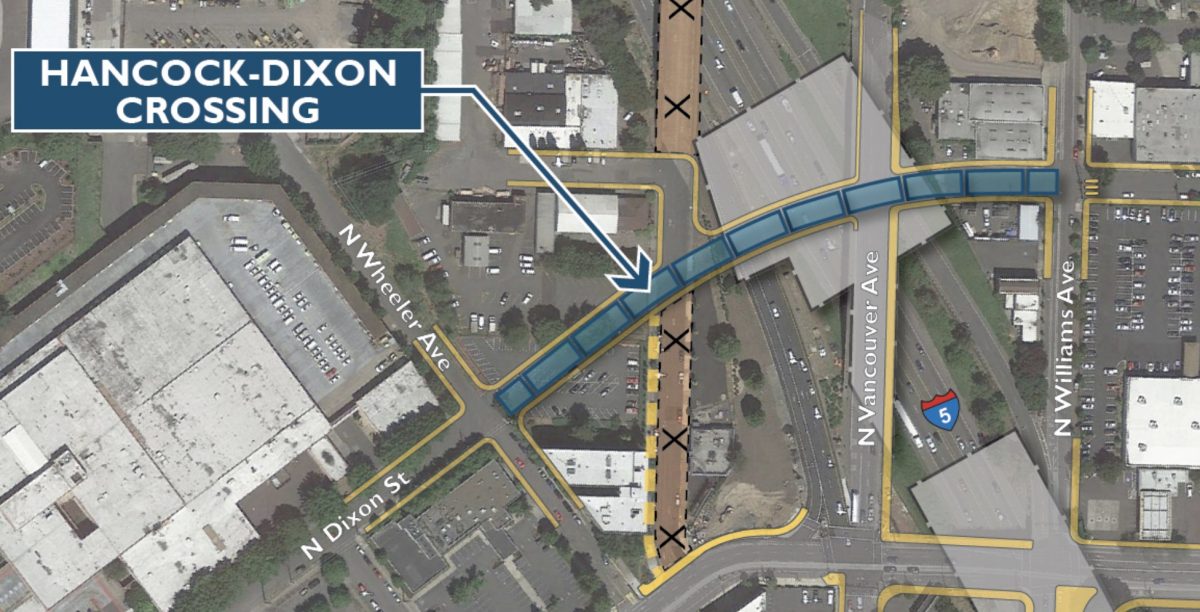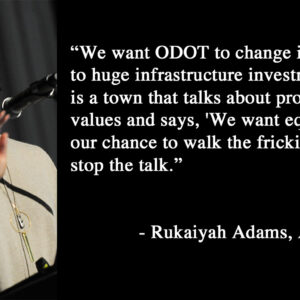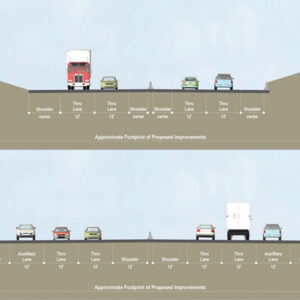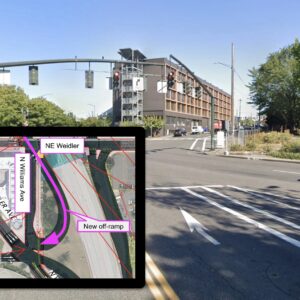One of the main points the Oregon Department of Transportation is using to sell their I-5 Rose Quarter project is that it will vastly improve cycling and walking conditions on the surface streets above the freeway.
Turns out that’s not exactly the case. The two official committees that advise the City of Portland on cycling and walking strongly oppose the project and recommend a “No Build”. That’s awkward because the Portland Bureau of Transportation is a key ODOT partner and has staked their support on the quality of surface street upgrades.
The position of the PBOT’s Bicycle Advisory Committee (BAC) and the PBOT Pedestrian Advisory Committee (PAC) should raise major red flags about the credibility of ODOT’s claims about this project.
In their March 22nd letter (PDF) to PBOT Commissioner Chloe Eudaly and ODOT Project Manager Megan Channell, BAC Chair Rithy Khut and Vice-Chair Elliot Akwai-Scott outline many major concerns about the proposed cycling infrastructure design and about ODOT’s handling of the project in general.
The BAC says they haven’t had enough time to provide meaningful feedback because of ODOT’s, “obfuscation and delay in providing information” and they have requested that a full Environmental Impact Statement (EIS) be prepared. Even with what they feel is limited information, the BAC has decided that, “the Build Alternative would fail to achieve the stated project goals and objectives, especially in critical areas related to bicycling, but also including the resulting conditions for walking and transit, local connectivity, safety, equity, and climate outcomes. This is in direct conflict with city and state planning goals.”
To put a finer point on it, the letter states: “The proposed bicycle facilities in the I-5 Rose Quarter project fail to provide meaningful safety improvements, improve travel times for bicyclists, or encourage the desired city-wide bicycle mode splits.”
Specifically, the BAC calls out the fact that ODOT’s proposal would mostly rebuild bikeways where they already exist — and it would remove the Flint Bridge which currently provides a direct connection that’s used by about 3,000 bicycle riders a day. The BAC says the negative impacts of losing Flint won’t be replaced by any of the proposed facilities. Another big concern is the fact that construction-related delays would have a significant negative impact on the approximately 8,000 bicycle users who travel through the project area every day. “After five years of construction,” the letter states, “the Build Alternative would not offer compelling or substantial improvements for bicycling.”
ODOT’s cycling pitch focuses on two new crossings: One at Hancock/Dixon and the other at Clackamas. The BAC pans the Hancock/Dixon crossing because it won’t include physically separated cycling facilities and it would include, “a permanently inaccessible 10% grade.” For perspective, that’s about the same as the steepest sections of Mt. Tabor. North Williams Avenue currently has about a 1.5 percent grade from the Rose Quarter heading north. The steepest part of the N Mississippi Avenue Hill is 6.5 percent. As for the Clackamas bridge, it would be carfree, but it doesn’t support any existing travel demands, the BAC says.
Advertisement

In general, the BAC says ODOT’s surface street proposals clearly put the needs of auto users above the needs of people bicycling and walking. Increased travel times for cycling (and transit too) and unsafe infrastructure with wide corner radii and unsafe transitions between two-way and one-way facilities.
That increased travel time flies directly in the face of Portland’s adopted Transportation System Plan (TSP), which states that major bikeways, “should be designed to… minimize delays by emphasizing the movement of bicycles.”
The BAC’s letter is based on an eight-page analysis of the project’s bicycling facilities that was created by PBOT staff for the committee. The analysis was based on information provided by ODOT in their Environmental Assessment (EA).
PBOT’s walking advisory committee plans to release a similar letter in the coming days. That letter will also request completion of a full EIS before the project moves forward. Portland-based nonprofit Oregon Walks has also come out against the project. In a statement posted to their website yesterday, the group says ODOT should “slow down the process” and that, “We cannot support a design for surface streets through the Rose Quarter that accommodates large vehicles at the expense of pedestrian safety.”
In related news, this strong opposition and demands for an EIS are shared by the Portland Public School Board. At their March 19th meeting, members of the board grilled ODOT and PBOT staff about how the project would impact Harriet Tubman Middle School. The sharply critical (borderline angry) questioning was the most detailed takedown of the project I’ve seen from elected officials thus far. You can watch the meeting via YouTube here.
The comment period for this project’s environmental assessment ends at 5:00 pm on April 1st. You can learn more and file a comment on ODOT’s website and/or at NoMoreFreewaysPDX.com.
— Jonathan Maus: (503) 706-8804, @jonathan_maus on Twitter and jonathan@bikeportland.org
Never miss a story. Sign-up for the daily BP Headlines email.
BikePortland needs your support.








Thanks for reading.
BikePortland has served this community with independent community journalism since 2005. We rely on subscriptions from readers like you to survive. Your financial support is vital in keeping this valuable resource alive and well.
Please subscribe today to strengthen and expand our work.
I can’t believe they are even considering a high traffic urban street with a 10% grade. Not only is this impossible for daily use by commuting and casual cyclists, but a safety nightmare during periods of snow or ice for automobiles. They might as well put a funicular railroad on it and let cyclists and pedestrians ride up and down like they are going up a ski hill.
I had to look that up. Amazing! I’d totally ride that. https://www.youtube.com/watch?v=G-7a0S5wsss
So I can picture it, any idea what the grade is for the Broadway Bridge (outbound)? I know people always mention the Tilikum Bridge has too steep of a grade, but I find Broadway more challenging (it is much shorter though.)
Tilikum is 5%. SW Vermont between 45th and 35th-ish is 10% (actually 9%). SW Condor Ave or SW Viepoint Terrace are also similar. Try it out! It is brutal! Tilikum looks like a walk in the park compared to those.
I use the route planning tools in RideWithGPS.com.
I have a garmin watch with a built in altimeter so…. not very helpful to you, sorry.
Another way to think of it is that the ADA maximum slope for a ramp in new construction is 8.3%, for no more than 30′ in length before a landing.
The standards for ramps in the ADA don’t apply to sidewalks, as far as I understand (i.e. the ADA doesn’t require that San Francisco regrade every street in the city).
But if I was designing an apartment building that was set back from the street, and had to provide an accessible route between the street and the front door, I would not be able to design it to the grades that Hancock / Dixon is being designed to.
My husband and I own the property known as Paramount Parking that is being taken by ODOT to create the new Hancock/Dixon.
My decades of bicycle and pedestrian safety advocacy, much of it specifically surrounding the notoriously dangerous Broadway/Flint/Wheeler intersection, apparently made us an easy mark for cooperation in the original design phase of this project. Allowing a bicycle and pedestrian ROW to be acquired through our property was represented as the fix to one of the most dangerous intersections in the city for bikes and peds.
Several aspects of the project that we were led to believe would improve our city are now missing or negatively altered on the current plan.
The new bike infrastructure was to be two-fold, promising:
– 1. The new Hancock-Dixon street that would run through our property would provide a safer, lower-stress route from N. Portland to the Broadway Bridge.
Instead, the new Hancock-Dixon St. will be an auto thoroughfare with painted bike lanes at a 10% grade that is now acknowledged by ODOT as likely being so unappealing to and unused by cyclists that they are not even indicating it on the maps they use in presenting active transportation infrastructure upgrades.
– 2. Additionally, the original plan showed two new MUPS running on ODOT property connected by the new Hancock/Dixon lid over I-5 that would effectively replace Flint Ave. The new off-street bike/ped paths were to connect the stubbed-off Flint at Tillamook to Broadway west of I-5.
Instead, of the two proper MUPS, one is completely missing, although ODOT said at March 4th meeting that it is still a “possibility”, and the other is not a MUP, but what I call BS. – BS stands for Bikes on Sidewalk – what engineers do when they can’t figure out what to do with bikes. This one is an elaborate and cramped 5%-grade switch-back MUP that will pit pedestrians and bicyclists against each other, and that few cyclists will use more than once.
This plan of passing through our property was represented as the solution to the need for a safer more comfortable bicycle route from North Portland to the Broadway Bridge.
Instead, it’s
‘No. Sorry. It’s the Vancouver/Broadway/I-5 Freeway intersection for you, bicycle riders.’
– Yes – this is the route we are left with that most bicycle commuters will opt for. It includes a shift of the bike lane from the right side to the left side of the Vancouver, funneling cyclists into a “jug-handle” staging area for a right turn from Vancouver to Broadway across the freeway off-ramps. Given the number of daily bike commuters on this route – the highest in the city – I think it highly unlikely that the 90-degree turn into the jug-handle and waiting for the light in the staging area will feel like an improvement over the right turn onto Broadway from Flint that we have now.
Betsy
Thanks for posting! I nominate for post of the week!
Flint Ave is still by far the best bike route available. ODOT simply doesn’t want to pay for the bridge underpinning or rebuild retrofit, not that I think that’s a good compromise for the overall project…but
Wow, that’s big time bait and switch! I second the nomination for post of the week.
The Portland Parks Board doesn’t seem that keen on the project either: https://efiles.portlandoregon.gov/Record/12825249/File/Document
Thanks… and FYI FWIW, two members of their board testified rather strongly against it at the public hearing.
I also seem to recall that this project only makes some on and off ramps for the highways a bit easier for cars to navigate. There is zero increase in actual travel lanes i.e. capacity for cars. Why oh why are we doing this???
Faster travel! Oh, no?
Congestion relief!! Still no?
Safety!!! Uhh, no?
Reconnect the grid!!!! Really, still no?
Ummm…..jobs?
ODOT has already said this will not allow for faster travel or congestion relief and it is being done for increased safety. ODOT controls a number of other roads that are far more dangerous than this section like 82nd and Powell. The grid is connected still just not in the most through way. We can spend the money on other projects that would still provide jobs for their completion.
I haven’t seen a particularly good response to why we wouldn’t spend this money on more dangerous roads first if it’s about safety. Do you know?
You may have misunderstood my comment. I was ticking off the justificaitons that have been thrown out thus far, and none have stuck. Each time, ODOT tries another. So no, it’s definitely not justified by safety. They want to build the thing, all the justificaitons are post hoc nonsense.
I think the answer is jobs. ODOT’s jobs, ODOT’s contractors’ jobs, and politicians’ jobs.
development potential (after 3 – 5 years of construction, wtf?).
” There is zero increase in actual travel lanes i.e. capacity for cars. ”
The project adds 3.2 miles of actual travel lanes. Yes, these lanes only connect the on-ramps to the off-ramps. They’re still lanes on a freeway.
I think this Hancock/Dixon grade may be ODOT’s Waterloo. In addition to destroying any kind of claims they might make about helping cyclists , such a grade is a non-starter with regards to emergency vehicles, city dump trucks pulling backhoes, and school buses. Yes such grades exist in the West Hills but they are legacy and not something any modern fire department or public works department will allow to be built from scratch. Hopefully this “oversight” will help to doom ODOT’s boondoggle.
My new idea: The Removal Option
ODOT should study the possibility of using the $500 million to remove I-5 from the Central Eastside riverfront. Presumably, that would allow them to connect I-84 directly to I-5 without any merging and certainly has the potential to reduce traffic and safety issues on this particular section.
In fact, last time their were proposed changes to I-5 in the 90’s – new on-ramps at Water Street – our city leaders stood up and demanded a better solution. They requested that ODOT explore removing or shifting the freeway away from the riverfront, and ODOT complied with a study.
Though it was ultimately deemed too expensive, our city leaders made a commitment to remove I-5 from the riverfront within the next 15-25 years. Guess what, that time is NOW and this is the perfect project and funding source to make that a reality!!
More about that history: https://www.pdx.edu/usp/planpdxorg-riverfront-people
Here’s a better idea: tear down I-405 and stitch back the downtown neighborhoods in NW and SW Portland that were devastated by the Stadium Freeeway. Or do those not count?
I’m all for discussing removal of any and all freeways through our urban area. I focus on I-5 on the central eastside because:
1. It has direct impacts on this particular ODOT project.
2. it cuts off access to our riverfront, the primary natural feature of our city.
3. There have already been 25 years of civic discussions about this particular removal project with several studies at the city and state level.
And because the impact in historic Albina was incredibly devastating to a community that has never fully recovered.
In the waning months of Sam Adams’ administration, he released a pretty interesting concept plan for burying I-5 in a tunnel under the Central Eastside: http://www.portlandonline.com/shared/cfm/image.cfm?id=392836
https://bikeportland.org/2012/04/06/adams-releases-i-5-tunnel-concept-plan-for-public-comment-70050
While this would be a freeway replacement rather than removal, I think something more like this is worthy of serious consideration for the following reasons:
–It could be combined with a tunnel to bury the freight railroad, removing all the at-grade crossings from Stark to 11th/12th, and that could also include dedicated commuter rail / Amtrak tracks.
–It could be combined with some kind of light rail tunnel connecting the Milwaukie Light Rail to Interstate Light Rail, providing the option to bypass downtown on some trips.
–It would be taken more seriously by ODOT compared to a full removal, and would be eligible for major highway funding sources both state and federal
–It could be modified to have no ramps at all, being a true freight and long-distance bypass route with I-405 being the local access route
–It could be modified to include a tunnel to replace the Marquam Bridge, which would be good from a seismic perspective.
I have gone and measured the slopes and the inclines in the area and 10% is way off. It came out somewhere 16 and 18% for over 300 feet. Special paving equipment would have to be designed to handle the slope with out sliding or rolling down the hill.
Cyclists when they got to the bottom may or may not make the corner as their brakes would be gone if they did not go over the handlebars.
Yeah anything over 15% is unrideable in optimal conditions by anyone but the most fit. I think some folks overestimate grading.
Cool, but let’s not forget the PBOT development cycle:
1. Identify problem
2. Develop solutions to problem
3. Workshop solutions with public
4. Accept solution least aligned with bureau policy
It’s telling that “implement solution” is notably absent from this list 😛
I just don’t even understand how PBOT especially but also ODOT would sign off on a 10% grade for folks on foot and bike and in wheelchairs. Did PBOT not notice? Did ODOT think no one would notice? (I’m not being naive here. It’s just that this seems like malfeasance.)
I do not think ODOT representatives ever saw the site except a 2D drawing or Google satellite picture. I am wondering about PBOT representatives as well.
Most of the elected officials who oversee and work with ODOT are asleep at the wheel. Every day more and more comes out about this project that they should know about already but are probably reading in the news.
Jonathan writes in the article, “Another big concern is the fact that construction-related delays would have a significant negative impact on the approximately 8,000 bicycle users who travel through the project area every day. ‘After five years of construction,’ the letter states, ‘the Build Alternative would not offer compelling or substantial improvements for bicycling.’”
This point needs to be made, again and again. ODOT (and PBOT too, but that’s another story) does a poor job of providing bicycle detours around their construction projects. Here’s a video showing an example from a much smaller project at Scholls Ferry and 217 from 2015.
https://youtu.be/X5CXjrufAg8
Yes, perhaps ODOT would do a better job with a bigger, longer project. Or, maybe since they can’t do a small project right, they can’t be expected to do a bigger project right, either. This is why I testified at the EA hearing that the project would effectively cut off bicycle infrastructure in this area for the duration of the project.
Yes, I also submitted a version of this comment to the public record through https://nomorefreewayspdx.com/publiccomment/
“What destroys the poetry of a city? Automobiles destroy it, and they destroy more than the poetry. All over America, all over Europe in fact, cities and towns are under assault by the automobile, are being literally destroyed by car culture. But cities are gradually learning that they don’t have to let it happen to them.”
– Lawrence Ferlinghetti (b. March 24, 1919) #happyonehundredthbirthday
From Betsy’s comment: “. . . It includes a shift of the bike lane from the right side to the left side of the Vancouver, funneling cyclists into a “jug-handle” staging area for a right turn. . .”
When this sort of thing shows up in even a proposal my first reaction is: bike lanes are bunk. A patently unworkable concept. I’d almost rather they’d make bikes illegal and we would just make the best way we can. It would at least be an honest policy, and cockroaches seem to be doing OK.
Usually I calm down a bit after that first reaction. I know the weird paint stripes will be ignored and a few seasons of studded tires will scrub away the asphalt they were sprayed onto.